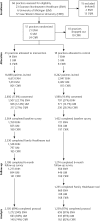Effect of preventive messages tailored to family history on health behaviors: the Family Healthware Impact Trial
- PMID: 21242555
- PMCID: PMC3022039
- DOI: 10.1370/afm.1197
Effect of preventive messages tailored to family history on health behaviors: the Family Healthware Impact Trial
Abstract
Purpose: We wanted to determine the impact of automated family history assessment and tailored messages for coronary heart disease, stroke, diabetes, colorectal, breast, and ovarian cancer on preventive behaviors compared with a standard preventive message.
Methods: The study was a cluster-randomized clinical trial that included 41 primary care practices, the majority in the Midwest, using Family Healthware, a self-administered, Web-based tool that assesses familial risk for the diseases and provides personalized risk-tailored messages. Patients in the control group received an age- and sex-specific health message related to lifestyle and screening. Smoking cessation, fruit and vegetable intake, physical activity, aspirin use, blood pressure, and cholesterol and blood glucose screening were assessed at baseline and 6 months after the intervention.
Results: Of 4,248 participants, 3,344 (78%) completed the study. Participants were white (91%), female (70%), and insured (97%), and had a mean age of 50.6 years (range 35-65 years). Intervention participants were more likely to increase daily fruit and vegetable consumption from 5 or fewer servings a day to 5 or more servings a day (OR = 1.29; 95% confidence interval [CI], 1.05-1.58) and to increase physical activity (OR = 1.47; 95% CI, 1.08-1.98) to 5 to 6 times a week for 30 minutes or more a week. The absolute differences in proportion were 3% and 4%, respectively. Intervention participants were less likely to move from not having cholesterol screening in the last 5 years to having their cholesterol measured within 5 years (OR = 0.34; 95% CI, 0.17-0.67), with an absolute difference of 15%.
Conclusions: Messages tailored to an individual's familial risk for 6 common diseases modestly increased self-reported physical activity and fruit and vegetable intake but reduced the likelihood of receiving cholesterol screening.
Figures
References
-
- Yoon PW, Chen B, Faucett A, et al. Public health impact of genetic tests at the end of the 20th century. Genet Med. 2001;3(6):405–410. - PubMed
-
- Khoury MJ, Gwinn M. What role for public health in genetics and vice versa? Community Genet. 2006;9(4):282, author reply 283. - PubMed
-
- Khoury MJ. Genetics and genomics in practice: the continuum from genetic disease to genetic information in health and disease. Genet Med. 2003;5(4):261–268. - PubMed
-
- Williams RR, Hunt SC, Heiss G, et al. Usefulness of cardiovascular family history data for population-based preventive medicine and medical research (the Health Family Tree Study and the NHLBI Family Heart Study). Am J Cardiol. 2001;87(2):129–135. - PubMed
-
- Acheson LS, Wiesner GL, Zyzanski SJ, Goodwin MA, Stange KC. Family history-taking in community family practice: implications for genetic screening. Genet Med. 2000;2(3):180–185. - PubMed
Publication types
MeSH terms
Substances
Grants and funding
LinkOut - more resources
Full Text Sources
Medical


